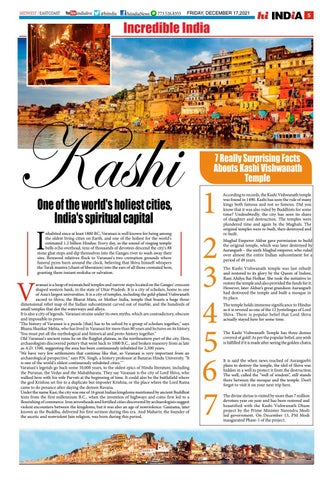MIDWEST / EASTCOAST
/hiindialive
@hiindia
/hiindiaNews
773.526.8353
FRIDAY, DECEMBER 17,2021
Incredible India
5
7 Really Surprising Facts Abouts Kashi Vishwanath Temple
One of the world's holiest cities, India's spiritual capital
I V
nhabited since at least 1800 BC, Varanasi is well known for being among the oldest living cities on Earth, and one of the holiest for the world's estimated 1.2 billion Hindus. Every day, as the sound of ringing temple bells echo overhead, tens of thousands of devotees descend the city's 88 stone ghat steps and dip themselves into the Ganges river to wash away their sins. Bereaved relatives flock to Varanasi's two cremation grounds where funeral pyres burn around the clock, believing that Shiva himself whispers the Tarak mantra (chant of liberation) into the ears of all those cremated here, granting them instant moksha or salvation.
aranasi is a heap of mismatched temples and narrow steps located on the Ganges' crescentshaped western bank, in the state of Uttar Pradesh. It is a city of scholars, home to one of Asia's largest universities. It is a city of temples, including the gold-plated Vishwanath sacred to Shiva; the Bharat Mata, or Mother India, temple that boasts a huge threedimensional relief map of the Indian subcontinent carved out of marble; and the hundreds of small temples that dot the waterways and alleys. It is also a city of legends. Varanasi strains under its own myths, which are contradictory, obscure and impossible to prove. "The history of Varanasi is a puzzle [that] has to be solved by a group of scholars together," says Bhanu Shankar Mehta, who has lived in Varanasi for more than 80 years and lectures on its history. "You must put all the mythological and historical and proto-history together." Old Varanasi's ancient ruins lie on the Rajghat plateau, in the northeastern part of the city. Here, archaeologists discovered pottery that went back to 1000 B.C., and broken masonry from as late as A.D. 1500, suggesting the area has been continuously inhabited for 2,500 years. "We have very few settlements that continue like that, so Varanasi is very important from an archaeological perspective," says P.N. Singh, a history professor at Banaras Hindu University. "It is one of the world's oldest continuously inhabited cities."" Varanasi's legends go back some 10,000 years, to the oldest epics of Hindu literature, including the Puranas, the Vedas and the Mahabharata. They say Varanasi is the city of Lord Shiva, who walked here with his wife Parvati at the beginning of time. It could also be the battlefield where the god Krishna set fire to a duplicate but imposter Krishna, or the place where the Lord Rama came to do penance after slaying the demon Ravana. Under the name Kasi, the city was one of 16 great Indian kingdoms mentioned by ancient Buddhist texts from the first millennium B.C., when the invention of highways and coins first led to a flourishing of commerce. Iron arrowheads and fortified cities discovered by archaeologists suggest violent encounters between the kingdoms, but it was also an age of nonviolence. Gautama, later known as the Buddha, delivered his first sermon during this era. And Mahavir, the founder of the ascetic and nonviolent Jain religion, was born during this period.
According to records, the Kashi Vishwanath temple was found in 1490. Kashi has seen the rule of many kings both famous and not so famous. Did you know that it was also ruled by Buddhists for some time? Undoubtedly, the city has seen its share of slaughter and destruction. The temples were plundered time and again by the Mughals. The original temples were re-built, then destroyed and re-built. Mughal Emperor Akbar gave permission to build the original temple, which was later destroyed by Aurangzeb – the sixth Mughal emperor, who ruled over almost the entire Indian subcontinent for a period of 49 years. The Kashi Vishwanath temple was last rebuilt and restored to its glory by the Queen of Indore, Rani Ahilya Bai Holkar. She took the initiative to restore the temple and also provided the funds for it. However, later Akbar’s great grandson Aurangzeb had destroyed the temple and built a mosque in its place. The temple holds immense significance to Hindus as it is revered as one of the 12 Jyotirlingas of Lord Shiva. There is popular belief that Lord Shiva actually stayed here for some time. The Kashi Vishwanath Temple has three domes covered of gold! As per the popular belief, any wish is fulfilled if it is made after seeing the golden chatra.
It is said the when news reached of Aurangzeb’s plans to destroy the temple, the idol of Shiva was hidden in a well to protect it from the destruction. The well, called the “well of wisdom”, still stands there between the mosque and the temple. Don’t forget to visit it on your next trip here. The divine shrine is visited by more than 7 million devotees year on year and has been restored and beautified with the Kashi Vishwanath Dham project by the Prime Minister Narendra Modiled government. On December 13, PM Modi inaugurated Phase-1 of the project.


